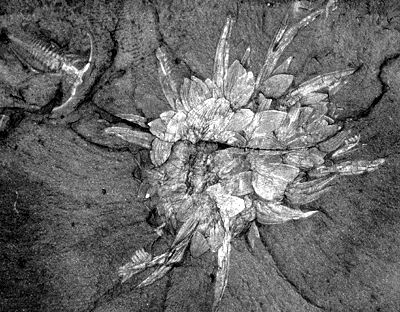 Return
Return
Wiwaxia

In 1899, Wiwaxia was first described on the basis of a single spine discovered in a Middle Cambrian bed on Mount Stephen, which lies across the valley from the Burgess Shale site. Later, after Walcott's discovery of the site, complete specimens became available and we can now show a more complete reconstruction. Those longer spines project in two rows along the back, and evidently provided some protection from predators. The rest of the upper (dorsal) surface is covered with small, flat, overlapping hard plates, termed sclerites. Each of these little scales was attached with a root-like base and we assume Wiwaxia grew by molting these plates from time to time. Since there are none on the bottom (ventral) surface, the animal partly resembles the slug, a member of the mollusk family. However, mollusks do not have any sclerite armor so the animal's affinity to present day species is unsettled. It did have an anterior jaw with two rows of teeth on the ventral surface, suggesting it was another bottom feeder. Fossil sizes range from 1/8 to 2 inches.
.
 Return
Return
